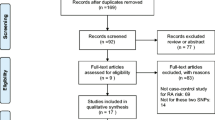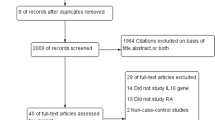Abstract
Rheumatoid arthritis (RA) is a chronic systemic disorder characterized by the development through angiogenesis, which is dependent on endothelial cell activation, migration and proliferation and CCL21 plays an important role in this pathology. Currently, CCL21 gene polymorphism studies on rheumatoid arthritis are scarce and the results are diverse. This meta-analysis was performed to determine if CCL21 gene polymorphisms correlate with the risk of developing RA. Association reports for the relationship between CCL21 polymorphisms and RA were identified from PubMed, Cochrane Library, Embase, SCIELO, CNKI and Wanfang databases on March 22, 2017. The odds ratio (OR) and 95% confidence interval (CI) were applied to assess the relationship strength. Publication bias was conducted with Begg’s funnel plot and Egger’s regression test to measure the robustness of our findings. Sensitivity and cumulative analyses were used to assess the overall robustness of the study’s results. Four relevant case–control cohort studies and three GWAS studies with CCL21rs2812378G>A gene polymorphisms and rheumatoid arthritis involving 9963 RA cases and 7976 controls were identified. Significant associations between the CCL21 rs2812378G>A polymorphism and RA risk were observed in the co-dominant model, dominant model and heterozygous model (A vs G: OR = 1.08, 95% CI = 1.03–1.14, p < 0.01, I 2 = 0.0%; AA + AG vs GG: OR = 1.15, 95% CI = 1.05–1.28, p < 0.01, I 2 = 0.0%; AG vs GG: OR = 1.18, 95% CI = 1.08–1.30, p < 0.01, I 2 = 3.8%) in the total population, as well as in subgroup Caucasian population. The combined analysis revealed a significantly increased risk of rheumatoid arthritis in the co-dominant model, dominant model and heterozygous model in overall population and subgroup Caucasian population.







Similar content being viewed by others
References
Mcinnes IB, Schett G (2011) The pathogenesis of rheumatoid arthritis—NEJM. N Engl J Med 365(23):2205–2219
Macgregor AJ, Snieder H, Rigby AS et al (2000) Characterizing the quantitative genetic contribution to rheumatoid arthritis using data from twins. Arthritis Rheumatol 43(1):30–37
Gregersen PK, Silver J, Winchester RJ (1987) The shared epitope hypothesis. An approach to understanding the molecular genetics of susceptibility to rheumatoid arthritis. Arthritis Rheumatol 30(11):1205–1213
Plenge RM, Seielstad M, Padyukov L et al (2007) TRAF1-C5 as a risk locus for rheumatoid arthritis—a genomewide study. N Engl J Med 357(12):1199–1209
Plenge RM, Cotsapas C, Davies L et al (2007) Two independent alleles at 6q23 associated with risk of rheumatoid arthritis. Nat Genet 39(12):1477–1482
Gunn MD, Tangemann K, Tam C et al (1998) A chemokine expressed in lymphoid high endothelial venules promotes the adhesion and chemotaxis of naive T lymphocytes. Proc Natl Acad Sci USA 95(1):258
Gunn MD, Kyuwa S, Tam C et al (1999) Mice lacking expression of secondary lymphoid organ, chemokine have defects in lymphocyte homing and dendritic cell localization. J Exp Med 189(3):451–460
Silva CCD, Lamerant-Fayel N, Paprocka M et al (2008) Selective human endothelial cell activation by chemokines as a guide to cell homing. Immunology 126(3):394–404
Weninger W, Carlsen HS, Goodarzi M et al (2003) Naive T cell recruitment to nonlymphoid tissues: a role for endothelium-expressed CC chemokine ligand 21 in autoimmune disease and lymphoid neogenesis. J Immunol (Baltimore Md.: 1950) 170(9):4638
Pickens SR, Chamberlain ND, Volin MV et al (2011) Characterization of CCL19 and CCL21 in rheumatoid arthritis. Arthritis Rheum 63(4):914–922
Bowes J, Ho P, Flynn E et al (2012) Comprehensive assessment of rheumatoid arthritis susceptibility loci in a large psoriatic arthritis cohort. Ann Rheum Dis 71(8):1350–1354
Wengner AM, Höpken UE, Petrow PK et al (2007) CXCR5- and CCR7-dependent lymphoid neogenesis in a murine model of chronic antigen-induced arthritis. Arthritis Rheum 56(10):3271–3283
Arnett FC, Edworthy SM, Bloch DA et al (1988) The American Rheumatism Association 1987 revised criteria for the classification of rheumatoid arthritis. Arthritis Rheumatol 31(3):315–324
Aletaha D, Neogi T, Silman AJ et al (2016) 2010 Rheumatoid arthritis classification criteria: an American College of Rheumatology/European League Against Rheumatism collaborative initiative. Arthritis Rheumatol 62(2):2569–2581
Egger M, Smith GD, Phillips AN (1998) Meta-analysis: principles and procedures. BMJ Clin Res 315(7121):1533–1537
O’Rourke K, Shea B, Wells GA (2001) Meta-analysis of clinical trials. In: Millard SP, Krause A (eds) Applied statistics in the pharmaceutical industry. Springer, New York. doi:10.1007/978-1-4757-3466-9_16
Godessart N, Kunkel SL (2001) Chemokines in autoimmune disease. Curr Opin Immunol 13(6):670–675
Martin AP, Coronel EC, Sano G et al (2004) A novel model for lymphocytic infiltration of the thyroid gland generated by transgenic expression of the CC chemokine CCL21. J Immunol 173(8):4791
Barone F, Bombardieri M, Manzo A et al (2005) Association of CXCL13 and CCL21 expression with the progressive organization of lymphoid-like structures in Sjogren’s syndrome. Arthritis Rheum 52(6):1773–1784
Orozco G, Eyre S, Hinks A et al (2010) Extended report: association of CD40 with rheumatoid arthritis confirmed in a large UK case-control study. Ann Rheum Dis 69(5):813–816
Raychaudhuri S, Remmers EF, Lee AT et al (2008) Common variants at CD40 and other loci confer risk of rheumatoid arthritis. Nat Genet 40(10):1216–1223
Elgabalawy HS, Robinson DB, Daha NA et al (2011) Non-HLA genes modulate the risk of rheumatoid arthritis associated with HLA-DRB1 in a susceptible North American Native population. Genes Immun 12(7):568–574
Willemze A, Trouw LA, Toes REM et al (2012) The influence of ACPA status and characteristics on the course of RA. Nat Rev Rheumatol 8(3):144–152
Zeng X (2015) The methodological quality assessment tools for pre-clinical and clinical studies, systematic review and meta-analysis, and clinical practice guideline: a systematic review. J Evid Based Med 8(1):2
Little J, Higgins J, Bray M et al (2006) The HuGENet™ HuGE review handbook, version 1.0
Author information
Authors and Affiliations
Corresponding author
Ethics declarations
Ethical statement
This article does not contain any studies with human participants performed by any of the authors.
Conflict of interest
The authors have no financial or nonfinancial conflicts of interest to declare.
Rights and permissions
About this article
Cite this article
Li, G., Zhao, J., Li, B. et al. Associations between CCL21 gene polymorphisms and susceptibility to rheumatoid arthritis: a meta-analysis. Rheumatol Int 37, 1673–1681 (2017). https://doi.org/10.1007/s00296-017-3784-4
Received:
Accepted:
Published:
Issue Date:
DOI: https://doi.org/10.1007/s00296-017-3784-4




